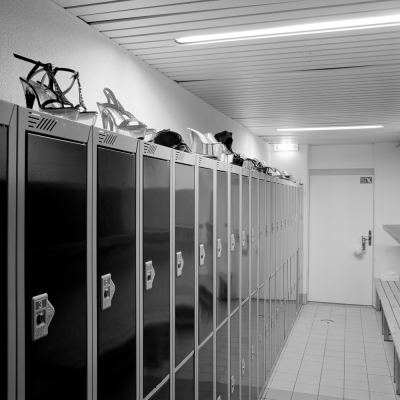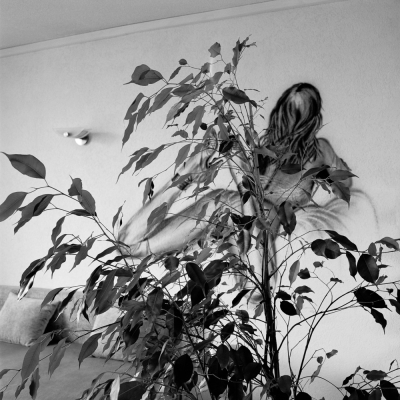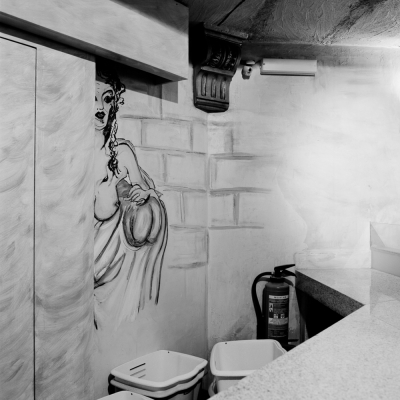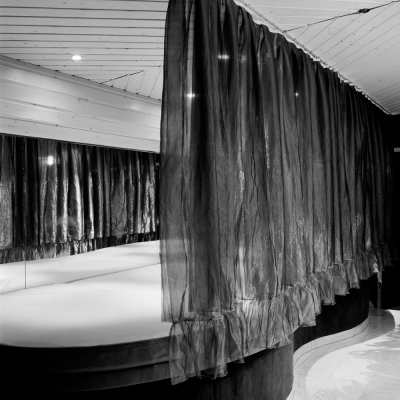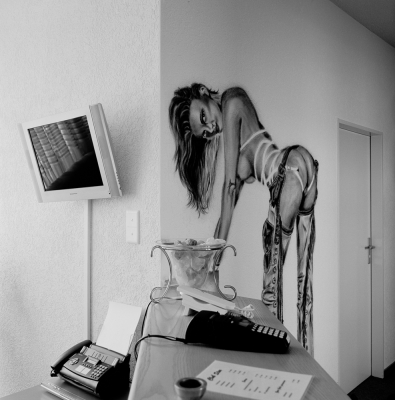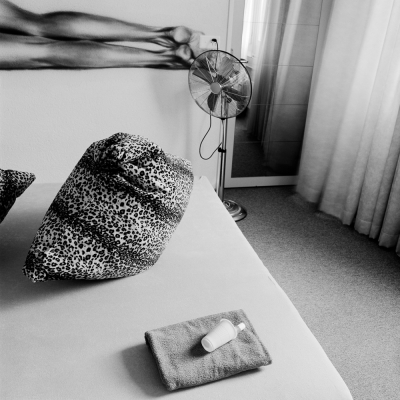Body Shops
BrothelsEssay by Nathalie Herschdorfer
Hygienic Space, Common Ground: The Photography of Juraj Lipscher
« The only way to understand something is to be confronted by something that is difficult to understand. »
Frederick Sommer [1]
« Our true study is that of the human condition »
Jean-Jacques Rousseau [2]
A hospital bed, medical apparatus, a landscape; a blackboard with a list of names crossed out, a calendar; gym equipment, a house plant, a stool; a corridor, clothes hung on a peg, a broom. Juraj Lipscher’s photographs show functional interiors. The titles not only indicate the type of space involved – a maternity ward, a beauty parlor, a crematorium, a bomb shelter – but also where they are located. When a title is divorced from its image, however, the viewer is at pains to say just what kind of space is depicted. A spectator who ignores the titles begins to realize that the spaces depicted share a large number of characteristics. In many ways, these interiors are all somewhat similar and even seem interchangeable. Juraj Lipscher’s pictures, therefore, echo one another in an endless series of variations.
Body Shops is about human beings although one hardly ever sees a human presence. What is shown are spaces devoted to the care of the body. Clinics for cosmetic surgery, morgues, and gyms – the environments photographed by Lipscher show us places where the human being is both omnipresent and totally absent. Equipment, machines, and pieces of furniture dominate settings that look like stage sets. Lipscher depicts environments where the body undergoes treatment, whether pleasurable or painful, in order to ensure its well-being. Maternity wards exist to take care of us at the beginning of our lives, beauty parlors to comfort us, gyms to build up our muscles, brothels to give pleasure, cosmetic surgery clinics to correct our imperfections, bomb shelters to protect us, morgues to examine our dead bodies and crematoriums to reduce us to dust. Lipscher photographs a world that looks after the human being from birth to death. Body Shops – shops for bodies – form a topography of the body in contemporary society.
Lipscher’s neutral style corresponds perfectly to the environments he observes. These interiors have been designed to fulfill a particular function and have no individual character, apart from rare exceptions such as the storage room full of coffins that has been decorated with posters of mountain landscapes. Lipscher’s approach is part of an important artistic tradition: that of documentary photography, which is indeed a tradition rather than a genre. In Germany in the 1920s and ’30s, a number of photographers who were interested in topologies of nature, architecture, and society formed a group known as the New Objectivity, a movement initiated by Albert Renger-Patzsch and August Sander. At the same time, in the United States, Walker Evens developed what he called the “documentary style” when he began to make a photographic archive of Victorian architecture [3].
In 1967, The Museum of Modern Art in New York held an exhibition entitled “New Documents”, which brought together the work of three photographers – Diane Arbus, Lee Friedlander, and Gary Winogrand – who were working with reality in a very straightforward way. In the 1970s, a whole school of photography advocating a documentary approach grew up around Bernd and Hilda Becher at the Kunstakademie in Düsseldorf. In the United States, yet another photographic exhibition, entitled “New Topographics: Photographs of a Man-altered Landscape” and held in 1975 at the George Eastman House in Rochester, underlined the need for photographers to adopt a neutral style in order to represent the contemporary world. The “new topographers” – Robert Adams, Lewis Baltz, Bernd, and Hilla Becher, Frank Gohlke and Stephen Shore, amongst others – developed an impersonal style for depicting landscapes and architecture in which there seemed to be neither “author”, nor “artist” [4]. In the 1970s, Lynne Cohen shot pictures of interiors devoid of any human presence. The spaces she chose – labs, classrooms, banqueting halls, offices, waiting rooms – seem like strange stage sets. Over the last fifteen years, enthusiasm for a neutral style that is both objective and impersonal illustrates the pre-eminence of a documentary approach to photography.
Lipscher claims to have been influenced by the work of Lewis Baltz, Frank Gohlke, and John Gossage. In 1996, while photographing industrial sites around Zurich and Baden, he did a series on waste incineration plants. He was interested in the immaculate white smoke rising above the incinerators. Lipscher was fascinated by the cleansing, purifying properties of fire. He continued his research in another related area, that of crematoriums, moving from the incineration of waste to the cremation of bodies. With these pictures, which were the starting point for the series Body Shops, the theme of humanity began to emerge in his work. The preoccupation with hygiene, however, was not abandoned and, on the contrary, became the unifying theme of the whole series. From this time on, Lipscher’s work has been concerned with the care lavished on the body in high-tech, sterile environments. In contemporary society, the body is treated like a simple object that can be manipulated, taken apart and put together again. In 1989, the American artist Barbara Kruger evoked this in the statement « Your body is a battleground ». Seeing the body as a battleground perfectly expresses the way we experience the flesh and blood of the physical self that is the object of so much care, ranging from simply combing one’s hair or doing physical exercise to cosmetic surgery.
By working in series, Lipscher is able to catalog a range of establishments that deal with the body and for nearly ten years, he has explored environments related to this theme. After working on crematoriums (1998) and maternity wards (2000), he began to visit morgues, gyms and beauty parlors (2001). He then investigated bomb shelters (2002) and, more recently, cosmetic surgery clinics and brothels (2007). Not the least of his merits is to have been able to enter environments like this that are often inaccessible. He has had to face mistrust when requesting permission to photograph “hidden” treasures, such as crematoriums, that are usually closed to the general public and that remain mysterious for this very reason. Approaching establishments of this kind is a complicated procedure that sometimes requires long and difficult negotiations.
Whatever their ultimate purpose, these interiors share a number of common values that are expressed in the way they are furnished and decorated. One is immediately struck by their cleanliness and by an inhuman, clinical and sterile atmosphere. Operating theatres would be an appropriate title for the series as a whole. By investigating themes that are closely related to one another, Lipscher highlights what these clinical, highly organized places bathed in artificial light have in common. Lipscher approaches these environments systematically, inspecting reception areas, corridors, and main rooms one after the other. The monochromatic, square images that are characteristic of Lipscher’s style accentuate the sterile appearance of these interiors. Although the vision of the world represented in these pictures can give one goose pimples, each space is socially and aesthetically interesting. Body Shops also contain flashes of humor when these impersonal environments are enlivened by a touch of kitsch in the furnishings. The sterile interiors of brothels, for instance, are photographed in full daylight without any seductive trappings and the pictures of cosmetic surgery clinics reveal a universe where each element is strategically positioned to reassure patients.
All the pictures were taken in Switzerland. Lipscher is fascinated by the cult of perfection in this country and has focused his attention on the culture that gave him refuge. After emigrating from Czechoslovakia in 1968, he settled in Zurich, where he has been living for the last forty years. Lipscher both identifies with his neighbors and feels different from the Swiss with their characteristic concern for technical perfection and a preoccupation with hygiene that is something of a national sport. The Civil Protection Policy and the nuclear bomb shelters installed all over the country also strike him as being specifically Swiss. The operating theatre installed in a bomb shelter at Zufikon, in the canton of Aargau, represents the quintessence of these functional, hygienic, impersonal spaces waiting to be used. The same monotonous atmosphere is present in all the sites he has photographed. The furnishing and equipment may well be modern and stylish, but these soulless interiors are nevertheless disturbingly lacking in human warmth. Is this related to a specific geographic region where public places are renowned for their cleanliness? In Body Shops, Switzerland is represented as a country where gyms, brothels, and crematoriums are administered as if they were engineering laboratories.
The simplicity and precision of his images suggest that Lipscher doesn’t take any detours. The photographer, who trained as a chemist, faces reality as it is. These places really do exist. They are not sets that have been made especially for the pictures. The photographs engage the viewer psychologically and, once the initial impression has worn off, one is sucked into these disturbing environments. Having taken the body as the object of his research, Lipscher analyses its status, place, and function in our society. The places he has chosen to photograph often raise questions about the human condition, such as life versus death, or finiteness versus perfectibility. We are all doomed to die but we wish to escape this fatality. Throughout our lives, we try to protect, improve and satisfy our fragile human bodies. This illustrates the paradox of mankind’s attempts to overcome imperfection and mortality. Our bodies are taken care of at birth and examined at death before being burnt as if in an act of purification. Lipscher conceals his personal convictions, prompting us to examine these spaces for ourselves and to question what goes on in them. He depicts a world of high technology with people controlling machines that are used on other human beings. What should we think of a world like this where the difference between pleasure and pain is erased, where morgues are not so different from maternity wards, where brothels resemble cosmetic surgery clinics and bomb shelters look like crematoriums? One of the most fascinating aspects of photography lies in its ability to merge reality with fiction and to transform ordinary places into the strangest of spaces.
[1] John Weiss (ed.), Venus, Jupiter and Mars: Photographs of Frederick Sommer, London, Traveling Light, 1980. p.16.
[2] Jean-Jacques Rousseau, Emile ou, De l’éducation, Paris, 1762.
[3] See : Oliver Lugon, Le style documentaire. D’August Sander à Walker Evans, 1920-1945, Paris, Macula, 2004.
[4] « The ideal photographic document would appear to be without author or art », Introduction by William Jenkins, New Topographics: Photography of a Man-altered Landscape, Rochester, George Eastman House, 1975, p.6.
Nathalie Herschdorfer, 2008
Essay by Juraj Lipscher
Body Shops
Text by Juraj Lipscher published in Visura Magazine, Issue 11, 2009 (shortened version)
We are pleased with our ability to mutate human bodies from weak to strong, from ugly to beautiful, from aroused to slackened, from
fat to lean. We build chambers for these tasks and we fit them with machinery and apparatus and paraphernalia and equipment and
gear. A child is born, a carnal need is assuaged, a sagging breast is lifted, a man dies. We stand ready, 24/7, our polished tools poised.
We are like medieval alchemists working on our opus magnum, converting blemished mortals into immaculate angels, our brightly lit
laboratories humming silently, awaiting the next transmutation. Standing in such rooms, I try to push my gaze beneath the stainless
steel surfaces to find some answers despite the glare of fluorescent lamps. How human, I ask myself, is a silicon breast presented on a
frosted glass stand in the immaculately furnished office of a plastic surgeon? Is it human to be beautiful or is it human to be ugly? How
human is a perfectly proportioned and idealized body, sculpted by a scalpel? How human is a brothel laid out like an ancient Egyptian
temple? And how human, then, is the prostitutes’ locker room in another brothel, an ordered array of high heels sitting on top of
each locker?
I have been exploring the topography of the corporeal existence in Switzerland for the last eleven years searching for and finding
establishments devoted to the care of the human body. This quest has been a unique experience for me as a human being and as a
photographer. I was forced to develop strategies to gain access to these premises. I had to explain myself and my motivations to every
establishment and the brothel proprietors, surgeons, and hospital administrators eventually trusted me because I was able to show
steadfastness.
These Body Shops, each of them, whether it is a maternity ward, beauty parlor or a crematorium, have a front desk, reception area or a mourning room for the general public and for the customers. They also have the back rooms where the work on the bodies gets done: the operating theater, the beauty machines, the ovens. We, run-of-the-mill humans, are not supposed to linger in the back rooms; we
immediately slip into the role of unwanted witnesses, onlookers, and voyeurs. However, I became one of the backroom boys, going in and
out, busied with my equipment, leading long conversations with the prostitutes, technicians, and cleaners and adopting the air of an old
hand An additional ethnographical dimension started to become visible in the course of my work. Looking at the images I started to discern
aspects of the Swiss national character encoded in these facilities. The investigation of the underlying features of the national character of the Swiss has evolved into one of my strongest motivations in photography in spite of, or perhaps because of the fact that I am actually a stranger in this country.
My photographs seem to fortify every cliché about the Swiss and then some. Swiss brothels and crematoriums, beauty parlors and
maternity wards are meticulously clean, they are spotless, they are immaculate. This is an important part of the Swiss professional pride
in general, accentuated by the hygiene fetishism and the legitimate need for cleanliness in such facilities in particular. But is this
immaculateness oppressive and is it thus inhuman? The answer, I hope, lies in the images.
